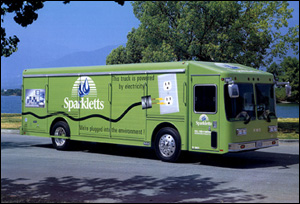Electric Delivery Trucks
TransPower electric drive products are well-suited to the operating needs of many of the hundreds of thousands of delivery trucks that operate every day in local regions across North America. Most local delivery trucks are driven less than 150 miles per day and are returned to the same location for parking and maintenance after each duty cycle. Such vehicles can take advantage of emerging battery technologies to operate quietly and with zero emissions, while eliminating their reliance on fossil fuels. Imagine the benefits of operating a delivery truck that never has to be driven to a service station for gas, an oil change, or a tune-up!
 |
Battery-electric bottled water delivery truck developed by ISE in the late 1990s. |
TransPower's electric drive products are focused on larger delivery trucks in the Class 7 and 8 range (heavier than 26,000 lb. gross vehicle weight), a weight range being ignored by most other suppliers of electric drive solutions. The feasibility of running large delivery trucks on electric power was demonstrated in the late 1990s by TransPower partner ISE, with an experimental low-floor battery electric truck built by ISE to deliver Sparkletts bottled water. Dependent on 1990s energy storage technology, this 30,000 lb. truck required 6,000 lb. of lead-acid batteries to achieve an operating range of about 50 miles. However, advances in battery technology over the past decade now enable delivery trucks to operate for much greater distances with significantly smaller battery packs. Using high-energy lithium batteries, a pack the size of the 1990s Sparkletts battery system provides enough energy to power a similar size truck for well over 100 miles.
With the support of partners such as ISE, TransPower can supply battery-electric drive systems for many of the larger beverage and package delivery trucks on the road today, along with trucks supporting the food industry and other applications. Yard hostlers, utility trucks, and construction vehicles are other promising candidates for electrification. Delivery trucks requiring refrigeration, utility trucks with booms, and construction vehicles such as cranes and dump trucks can draw auxiliary electric power from the drive system, eliminating their need to idle using diesel engines to run their auxiliary systems. Trucks with longer operating range or higher auxiliary energy requirements can be equipped with auxiliary hydrogen systems to augment their battery packs.
| 




